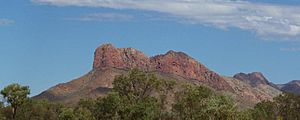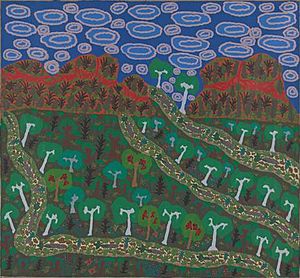Daisy Jugadai Napaltjarri facts for kids
Quick facts for kids
Daisy Jugadai Napaltjarri
|
|
|---|---|
| Born | c. 1955 Haasts Bluff, Northern Territory, Australia
|
| Died | 2008 (aged 52–53) |
| Nationality | Australian |
| Known for | Painting |
| Awards | Finalist, National Aboriginal & Torres Strait Islander Art Award: 1995, 1998, 2001 Section winner, NATSIAA: 2000 |
Daisy Jugadai Napaltjarri (born around 1955, died 2008) was an amazing Indigenous Australian artist. She spoke the Pintupi-Luritja language. Daisy came from the Western Desert region of Australia. Her sister, Molly Jugadai Napaltjarri, was also a talented artist.
Daisy Jugadai lived and painted in a place called Haasts Bluff, Northern Territory. She helped start the Ikuntji Women's Centre. This centre became a special place where many artists from the area could work. Daisy's art was inspired by her Tjuukurrpa. This is a deep spiritual knowledge about her land. Her paintings also showed how carefully she observed plants and the environment.
Daisy's artworks were chosen for the National Aboriginal & Torres Strait Islander Art Awards five times. This was between 1993 and 2001. She even won a section award in 2000. Her paintings are now kept in big art collections. These include the National Gallery of Victoria and the National Gallery of Australia.
Contents
Daisy Jugadai's Life
Daisy Jugadai was born around 1955. Her birthplace was Haasts Bluff, Northern Territory. Her parents, Narputta Nangala and Timmy Jugadai Tjungurrayi, were also artists. The exact year of her birth is not certain. This is because Indigenous people often measure time differently. They might compare dates to other important events.
People from Papunya and Haasts Bluff, like Daisy, speak Pintupi-Luritja. This is a dialect of the Western Desert language. Napaltjarri is a "skin name." These names are part of a special system. They show family relationships among Indigenous people. Skin names help decide who can marry whom. They are also linked to certain totems. These names are not like European surnames. "Daisy Jugadai" is the part of her name that is truly hers.
Daisy spent her childhood in Haasts Bluff and a nearby camp called Five Mile. She went to school in Papunya. Later, she married Kelly Multa. They had a daughter named Agnes. They lived at an outstation called Kungkayunti. After Kelly died, Daisy moved back to Haasts Bluff.
In the 1990s, she married again. Her new husband was from Elcho Island. Daisy then traveled often between Arnhem Land and Haasts Bluff. She passed away in 2008. Her funeral was held in Haasts Bluff, where she was born. Daisy had an older sister, Molly Jugadai Napaltjarri. She also had another sister, Ester, who died before her.
Daisy Jugadai's Art
How Her Art Started
Modern contemporary Indigenous Australian art began in 1971. Indigenous men in Papunya started painting. Teachers like Geoffrey Bardon helped them. They used acrylic paints to create designs. These designs often came from body painting and ground sculptures. This new art style quickly spread. It became popular in Indigenous communities across central Australia.
At first, only men were painting. But many women wanted to join in. In the 1990s, many women began to create paintings. People in places like Kintore and Yuendumu started making art. They created art specifically to show and sell.
Daisy Jugadai came from a family of artists. Her uncle, Uta Uta Tjangala, and her mother were painters. Daisy learned to draw at school. Her first painting experience was helping her father. She painted backgrounds for his pictures. Daisy was one of many artists who started painting through the Ikuntji Women's Centre. This was in the early 1990s. She played a big part in setting up the centre.
She first tried screen printing and linocut printmaking. But she soon switched to acrylic painting. Many of her best works were made in the mid-1990s. Western Desert artists like Daisy often paint specific 'dreamings' or Tjukurrpa. This is a complex idea. Tjukurrpa means spiritual knowledge of the land. It also includes rules and stories that people must keep alive. Daisy painted dreamings that were her own. She also painted those of her late husband and father. These included honey ant, spinifex, and emu dreamings. Her paintings showed places like Muruntji waterhole and Talabarrdi. These were places around Kungkayunti, where her family lived.
Her Art Career
Throughout the 1990s, Daisy Jugadai often showed her art. She exhibited at the Araluen Art Centre in Alice Springs. She also showed her work at other big exhibitions. For example, she was in the Australian Heritage Art Awards in Canberra in 1994. She gained recognition in 1993. She won a Northern Territory Women's Fellowship. Also, the Araluen Arts Centre bought one of her works.
Daisy was an administrator in her community, as well as an artist. She was part of the Ikuntji Women's Centre. She also represented her community on the Ikuntji Community Council. Daisy helped convince them to hire Marina Strocchi as an art centre coordinator. The two women respected each other. Daisy's work was chosen for a special exhibition. This show, called Ikuntji tjuta – touring, traveled around Australia. Marina Strocchi curated it.
Daisy Jugadai's artworks are held in important collections. These include the National Gallery of Victoria and the National Gallery of Australia. They are also in the Museum and Art Gallery of the Northern Territory. She was a finalist in the National Aboriginal & Torres Strait Islander Art Awards many times. This was in 1995, 1998, and 2001. She won a section award in 2000. Her 1994 artwork, Karu kapingku pungu (Creek after rain), is at the Museum and Art Gallery of the Northern Territory. Her art is also displayed at the Melbourne international airport terminal. It is shown alongside other Indigenous artists. One of her paintings, Antiti, near Five Mile (1998), was even on the cover of the Medical Journal of Australia.
Her Painting Style
Daisy Jugadai was unique among Ikuntji artists. She was the only one who worked at an easel. She said the Hermannsburg School influenced her. This group of Indigenous artists included Albert Namatjira. They started painting at Hermannsburg Mission in the 1930s.
Her painting Memory and Five Mile Creek (1995) shows the land where she grew up. It shows the hills of the region from a side view, not from above. It also shows the many different plants found there. Curator Marina Strocchi noted Daisy's careful observation. Her paintings showed the complex details of plants and the environment. She "obsessively detailed" features. Daisy "devotedly included all the bush tucker of that area." She also chose a specific time of year to show her country.
She painted plants carefully with a trimmed brush. For even finer details, like pollen, she used a matchstick. Clouds were always the last thing she added. Even with all this detail, Daisy preferred to paint on large canvases. Memory and Five Mile Creek was shown in a 2004–05 exhibition. A reviewer called it "naive charm." But they also noted its title. This suggested that Daisy, like other artists, might be talking about the impact of people losing their land.
Artist Mandy Martin worked with Daisy in 2005. She thought Daisy's way of showing bush tucker was "dazzling." Writer Morag Fraser called Daisy's work "extraordinary." She said Daisy's paintings showed nature in a very personal way. Daisy was a respected artist in her community. Her death happened at a time when many new artists were starting to express themselves.



